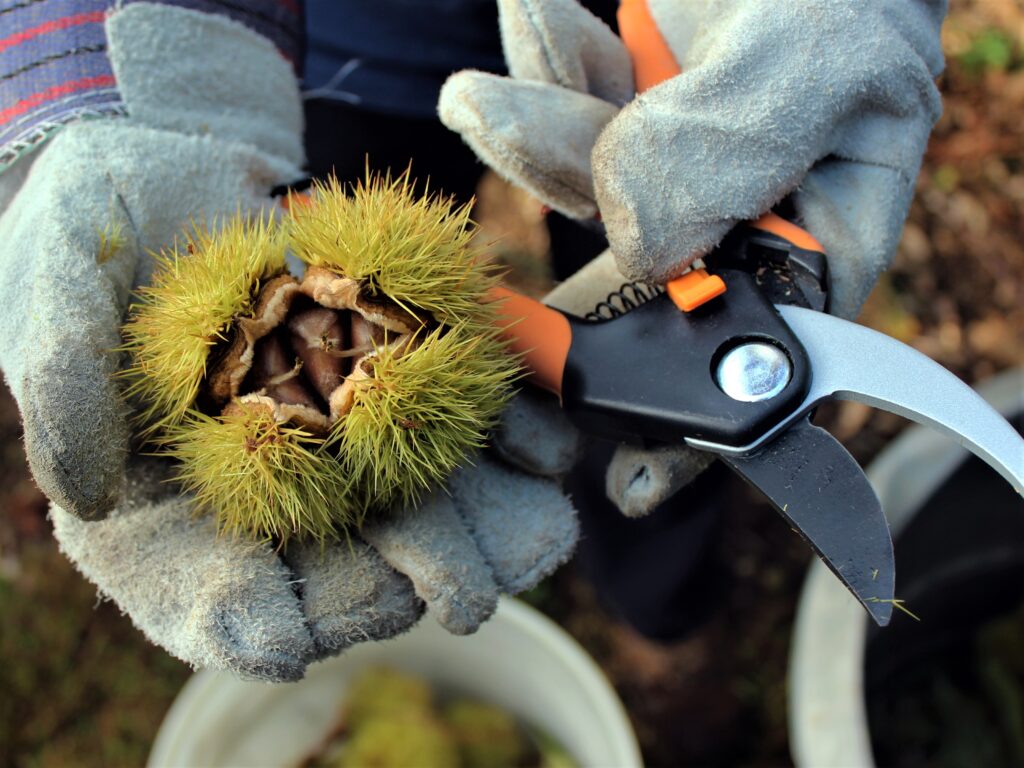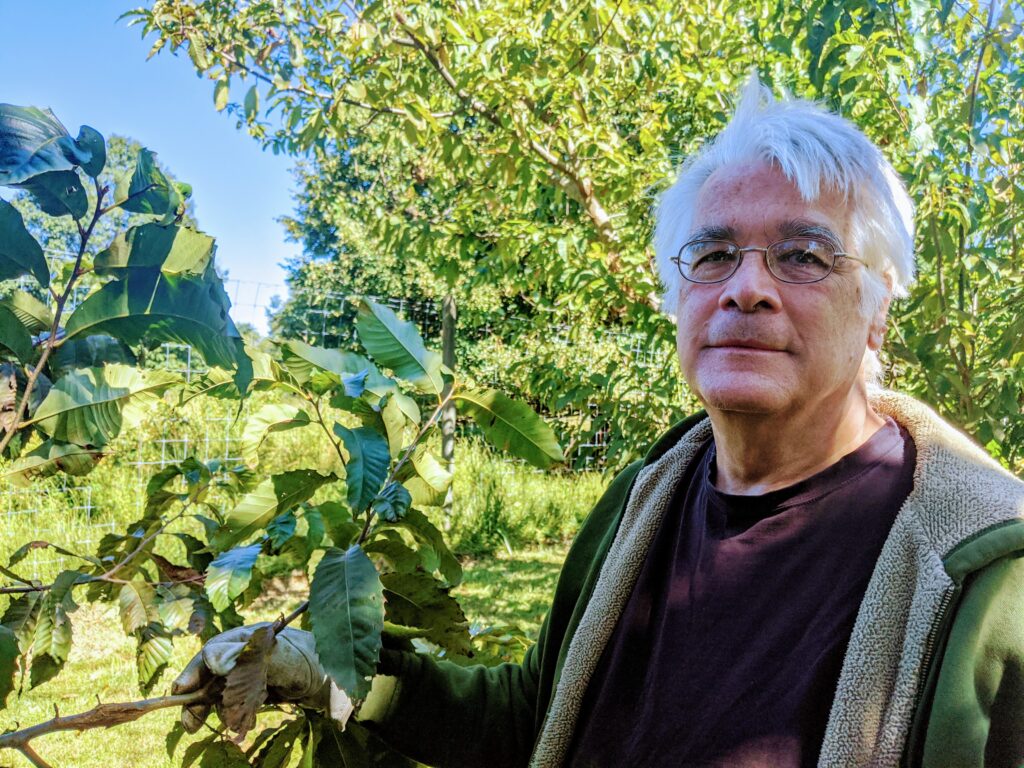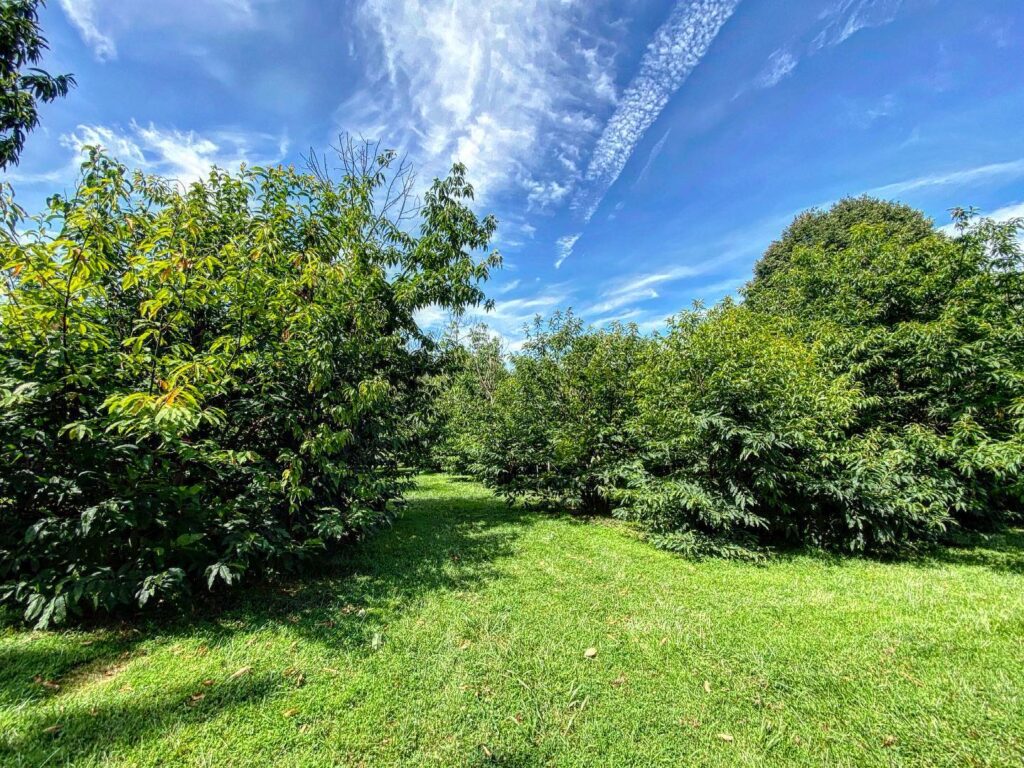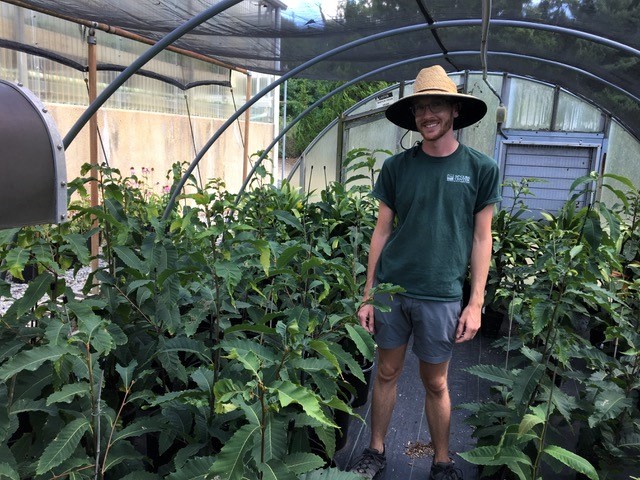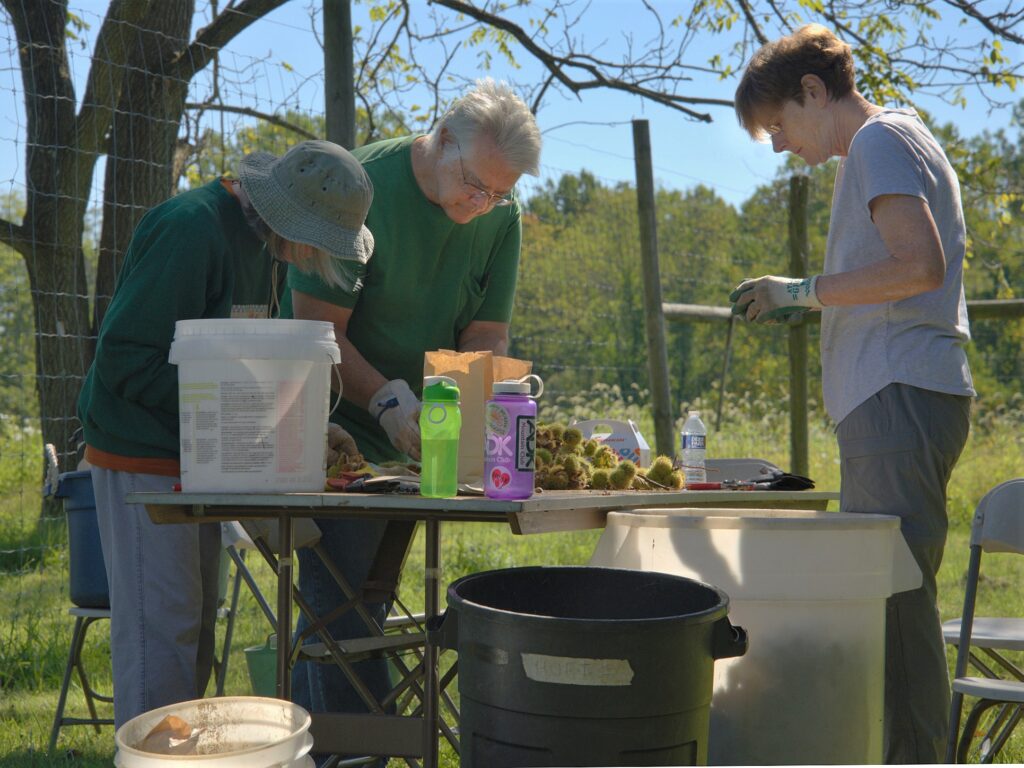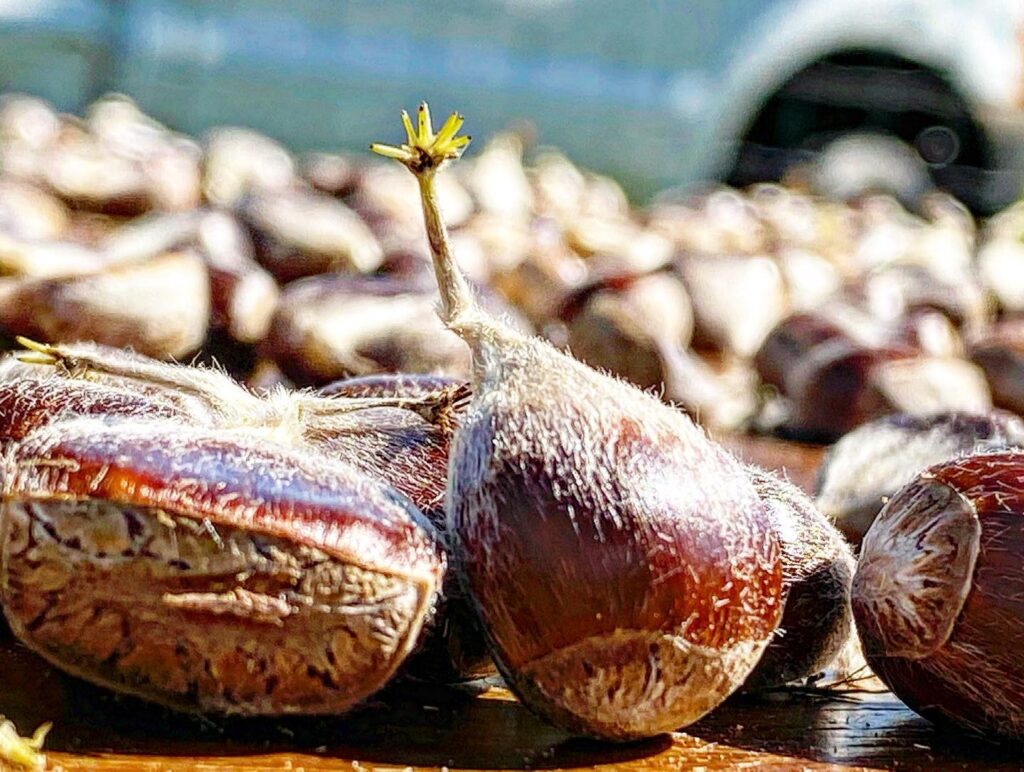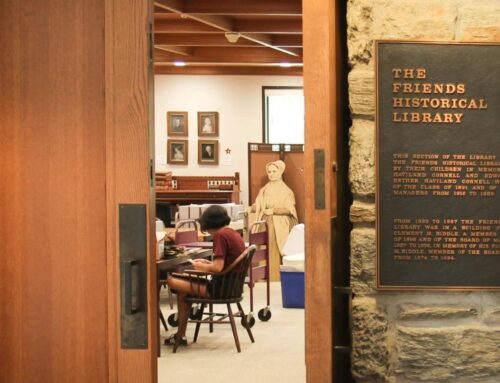The right plant, the right people, the right place. This is the story of a magic moment where the universe lined up for the American chestnut – and how one tree and a network of organizations and expert volunteers might change the face of the Eastern forest, from Maine all the way down to Georgia.
It begins in 2019 with a hunter on a hike in the Coverdale Farm Preserve in Greenville, Delaware. The story is famous now – at least for devotees of the American chestnut. You can read about it on WHYY: “Eagle Eyed Delaware Hunter chances upon Holy Grail of tree lovers – a full-grown American Chestnut.” This sharp-eyed individual spotted the tree more than three years ago, Delaware’s the last known American chestnut (Castanea dentata). Before the discovery of the Coverdale chestnut, experts believed the tree to be extinct in the state, a victim of the blight that swept through in the early 20th century.
The Coverdale chestnut stands 65 feet tall, with a diameter at breast height (DBH) of 18 inches. Of the more than 500 documented remaining American chestnut trees, the Coverdale chestnut is larger than an astonishing 95% of them. The tree bears some evidence of the blight, but the damage is minor, and the trunk is straight and strong. Dan O’Keefe, biological scientist and Tyler Volunteer, and John Wenderoth, Tyler Volunteer and former president of the Pennsylvania chapter of TACF, took leaf samples and analyzed the tree’s DNA as part of a program sponsored by TACF at Virginia Tech. The genetics confirmed their hopes – the tree is pure American, C. dentata, rather than a hybrid cross with the Chinese chestnut, C. mollissima.
There is something else remarkable about this special tree. It flowers! Each June, the Coverdale chestnut opens up white catkins of blooms that, although they contain both male and female flowers, cannot produce viable seeds unless pollinated by a different chestnut tree. Chestnuts are not generally self-fertile, and since the Coverdale chestnut stands alone, pollen from other surviving chestnuts can’t reach it.
The Coverdale chestnut is doing its part by surviving year after year – no small task against the many challenges it faces. However, for it to reproduce and contribute genetics to a new generation of chestnuts, it needs a little human help. That’s where our team comes in.
In July 2020, a group of arborists from Mt. Cuba Center, David Pro from the Delaware Nature Center and Tyler volunteers Eric Rinehimer and Dan O’Keefe made the trek out to the Coverdale chestnut to collect pollen. Arborist Eric Kelley made the climb up to the canopy. According to Dan, “…to us on the ground, it looked like he was walking on twigs” as he collected a bag full of catkins. Dan took a video that you can watch here.
A love of chestnuts brought this team together – scientists, foresters, arborists and plant enthusiasts from four organizations, each person dedicated to nothing less than the resurrection of a species. The Coverdale chestnut is exactly what they were searching for: Genetics from a mature, surviving Castanea dentata. A brand new treasure trove of potential to breed resistance into a new generation of chestnuts.
Next step – the Tyler Arboretum Chestnut Orchard.
The Chestnut Orchard is where Tyler volunteers carry on the important work started by the American Chestnut Foundation.This organization, which will reach its 40th anniversary next year, is part of the massive citizen science project dedicated to restoring the American chestnut tree to its native range. The three-part approach to overcoming the effects of the blight is called 3BUR. It includes Breeding (using the blight-resistant Chinese chestnut), Biotechnology (using genetic modification with a blight-resistance gene), and Biocontrol (using a phenomenon called hypo virulence). You can find more information about the Tyler Chestnut Orchard on our YouTube Channel.
The important part, at least for the Coverdale chestnut, is that the over 100 trees in the Tyler Orchard represent a preserve of living American chestnuts collected from 12 surviving trees in 12 different parts of Pennsylvania. In the wild, these 12 trees are unable to interact. Each year they would flower and produce pollen that could never travel far enough to encounter another living member of its species. However, in the Tyler Orchard, genetics from these 12 lineages – now 13 lineages with the addition of the Coverdale chestnut – can mix, combine, and perhaps create that ‘holy grail’ of trees, a truly blight-resistant American chestnut.
That June, Dan carefully collected pollen from the catkins of the Coverdale chestnut and drove them to the Orchard at Tyler Arboretum. It was the first summer of the COVID-19 Pandemic, where visitation and volunteer hours were strictly limited. Against the backdrop of great uncertainty – about the future and the safety of working together, even outdoors – Dan and John applied the pollen to the bagged female flower of one branch of one chestnut.
We’re fortunate here at Tyler to have the expertise of these two volunteers. Dan is a biological scientist who, when he retired, wanted to volunteer where his unique skill-set could be put to good use. John, former president of PA/NJ Chapter of TACF gave him a great overview of the work being done by volunteers in the Tyler Chestnut Orchard and the two went to work. Thanks to Dan, John and the rest of the chestnut team the hard work of maintaining and pollinating these trees, and harvesting the resulting nuts, is completed each year.
Unfortunately, the branch that had been pollinated with pollen from the Coverdale chestnut succumbed to the blight in the late summer months of 2020. Volunteers collected a few nuts, but none had ripened enough to be viable, so germination could not occur.
Lucky for the chestnuts, Dan had a plan. It is possible to store pollen for several seasons, so volunteers were able to use the leftover pollen from 2020 for controlled pollination of four different trees in the orchard in 2021. The result was well over 100 nuts collected by volunteers in September.
From there, these precious seeds traveled to their next stop – Mt. Cuba Center in Hockessin, Delaware. James Rockwell, Greenhouse and Nursery Manager, started the trees in February 2022. James cared for these trees in the Mt. Cuba Center greenhouse throughout the growing season, and the little saplings, the progeny of the surviving chestnuts of Pennsylvania and Delaware took root and grew.
“When we went to visit them in August it was astonishing how big they had gotten in one growing season,” says Dan O’Keefe. A few of these special trees were set aside for planting at Mt. Cuba Center and the Ashland Nature Center. Then, with the assistance of Senior Gardener Austin Deputy, volunteers tilled and mulched spaces for 25 trees in the Tyler Chestnut Orchard. These trees were planted on a rainy day this October.
According to Dan, “…It’s an important part of the conservation of these trees that once constituted 40% of the trees in the woods around Delaware County. The Coverdale Farms tree is a reminder of that, but because it is isolated from other chestnut trees capable of pollinating it, it is unlikely to produce any viable seeds. So, we did the next best thing by using it to pollinate trees in the Tyler Orchard. That provides a means to conserve the characteristics of this tree until better methods of fighting the blight become available.”
We don’t know yet what will become of those saplings, but we do know the role they will play and the role they have already played. They contain the best hope of a species, the genetics that – with each new combination – may produce a survivor. Each mature living chestnut we find brings us one step closer to the return of a tree that looms large both in the ecology of its native range and in the folk story of America.
You can find echoes of this folk story in the Tyler Orchard as volunteers engage in the companionable activity of cleaning the nuts. Volunteers shuck the sweet nuts from the spiny burrs each fall and pack them in peat moss to preserve them for the winter. Of course, some of the nuts are taste-tested. Though roasting is popular, the sweet American chestnut has sustained generations and is delicious fresh from the tree. Despite the sharp spines, picking and processing chestnuts is a pleasant task for the bright blue days of early fall in Southeastern Pennsylvania and a time-honored tradition.
Work in the Tyler Arboretum Chestnut Orchard will continue into 2023 and beyond. One day we hope visitors to Tyler will hike through forests filled with the blooming white catkins of mature chestnuts, descendants of the Coverdale chestnut and other trees like it. Each September, the small, shiny nuts we harvest bring us closer. These seeds represent a living link in a chain that stretches back into history – forward into the future.
Want to plant your OWN American chestnut? Learn more about how to get involved, and get planting from the PA/NJ Chapter of the American Chestnut Foundation.


